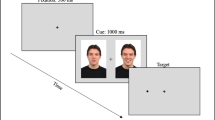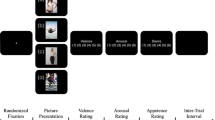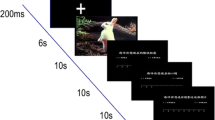Abstract
Decades of research have shown that the left- and right-frontal cortical regions are asymmetrically involved in affective processing. Specifically, this past work has demonstrated that greater left-frontal activation is related to positive-approach, and greater right-frontal activation is related to negative-withdrawal. However, much of this past work confounded motivation and affective valence. The current experiment sought to illuminate whether frontal asymmetry is related to motivation or affective valence by examining frontal-lateralized late positive potentials (f-LPPs) and frontal cortical alpha power activation to approach-positive, approach-negative, and withdrawal-negative affects in the same participants. Results revealed that f-LPPs to approach-positive and approach-negative pictures were larger in left- (vs. right-) frontal regions, whereas f-LPPs to withdrawal-negative pictures did not differ between frontal regions. In addition, midline LPPs to approach-positive and approach-negative pictures related to greater left-frontal cortical activation. Together, these results suggest that greater relative left-frontal activation is associated with positive and negative approach-motivated states in the same participants. More broadly, these results are consistent with conceptual models that asymmetric hemisphere activation is related to motivational direction, rather than affective valence.



Similar content being viewed by others
Notes
We conceptualize motivation as the impetus an organism experiences to go toward versus the motivation to freeze or move away. Approach motivation has been associated with the behavioral approach system (BAS; Gray 1970, 1987; Gray and McNaughton 2000), behavioral activation system (also BAS; Fowles 1987), or a behavioral facilitation system (Depue and Collins 1999). Withdrawal motivation has been associated with the behavioral inhibition system (BIS; Gray 1970, 1987). This system is thought to modulate reactions to aversive stimuli and generate negative affective states such as fear and anxiety. The distinct motivational responses to approach or avoid are inherent in affective responses.
Some past research has investigated hemispheric asymmetry using beta frequency band power (Swann et al. 2009). The majority of this work has been focused on posterior asymmetry, but some has also examined frontal asymmetry (Hofman and Schutter 2012; Keune et al. 2012). We focused on the alpha band because the majority of studies examining frontal asymmetry have used the alpha band and frontal alpha asymmetry is supported by a variety of methods (e.g., lesion studies, TMS, fMRI).
IAPS picture numbers: neutral pictures (2038, 2102, 2190, 2191, 2200, 2210, 2214, 2215, 2381, 2385, 2396, 2397, 2440, 2441, 2493, 2495, 2499, 2514, 2516, 2595, 2850, 2870, 2880, 2890, 5471, 5510, 5531, 5533, 5535, 5740, 6150, 7000, 7002, 7004, 7006, 7010, 7020, 7034, 7035, 7038, 7041, 7043, 7052, 7053, 7056, 7058, 7059, 7080, 7090, 7100, 7160, 7161, 7170, 7175, 7179, 7182, 7185, 7187, 7211, 7217, 7233, 7235, 7242, 7247, 7248, 7249, 7500, 7547, 7550, 7640, 7830, 7950, 9070); withdrawal-negative pictures (1270, 1274, 1275, 1280, 1617, 3017, 3061, 3160, 3210, 3215, 7359, 7360, 7361, 7380, 9008, 9042, 9110, 9180, 9182, 9301, 9320, 9341, 9373, 9390, 9432, 9440, 9480, 9490, 9582, 9592, 9594, 9830); and approach-positive pictures (1441, 1463, 1710, 1750, 1920, 2040, 2070, 2071, 2080, 2091, 2150, 2165, 2340, 2345, 2550, 4608, 4650, 4652, 4660, 4676, 4680, 4687, 4689, 4694, 4695, 7283, 7330, 7340, 7390, 7402, 7410, 7430).
References
Ahern GL, Schwartz GE (1985) Differential lateralization for positive and negative emotion in the human brain: EEG spectral analysis. Neuropsychologia 23:745–755
Balconi M, Falbo X, Conte X (2012) BIS and BAS correlates with psychophysiological and cortical response systems during aversive and appetitive emotional stimuli processing. Motiv Emot 36:218–231
Bartholow BD, Pearson MA, Gratton G, Fabiani M (2003) Effects of alcohol on person perception: a social cognitive neuroscience approach. J Personal Soc Psychol 85:627–638
Bradley MM (2009) Natural selective attention: orienting and emotion. Psychophysiology 46:1–11
Bradley MM, Lang PJ (2007) Emotion and motivation. In: Cacioppo JT, Tassinary LG, Berntson G (eds) Handbook of psychophysiology, 3rd edn. Cambridge University Press, New York, pp 581–607
Buss KA, Malmstadt Schumacher JR, Dolski I, Kalin NH, Goldsmith HH, Davidson RJ (2003) Right frontal brain activity, cortisol, and withdrawal behavior in 6-month-old infants. Behav Neurosci 117:11–20
Carver CS, Harmon-Jones E (2009) Anger is an approach-related affect: evidence and implications. Psychol Bull 135:183–204
Coan JA, Allen JJB (2004) Frontal EEG asymmetry as a moderator and mediator of emotion. Biol Psychol 67:7–49
Cook IA, O’Hara R, Uijtdehaage SHJ, Mandelkern M, Leuchter AF (1998) Assessing the accuracy of topographic EEG mapping for determining local brain function. Electroencephalogr Clin Neurophysiol 107:408–414
Cunningham WA, Espinet SD, DeYoung CG, Zelazo PD (2005) Attitudes to the right- and left: frontal ERP asymmetries associated with stimulus valence and processing goals. NeuroImage 28:827–834
Davidson RJ, Chapman JP, Chapman LJ, Henriques JB (1990a) Asymmetrical brain electrical activity discriminates between psychometrically-matched verbal and spatial cognitive tasks. Psychophysiology 27:528–543
Davidson RJ, Ekman P, Saron CD, Senulis JA, Friesen WV (1990b) Approach-withdrawal and cerebral asymmetry: emotional expression and brain physiology I. J Personal Soc Psychol 58:330–341
Depue RA, Collins PF (1999) Neuobiology of the structure of personality: dopamine, facilitation of incentive motivation, and extraversion. Behav Brain Sci 22:491–569
Elgavish E, Halpern D, Dikman Z, Allen JJB (2003) Does frontal EEG asymmetry moderate or mediate responses to the international affective picture system (IAPS)? Psychophysiology 40:s38
Ferrari V, Codispoti M, Cardinale R, Bradley MM (2008) Directed and motivated attention during processing of natural scenes. J Cogn Neurosci 20:1753–1761
Fowles DC (1987) Application of a behavioral theory of motivation to the concepts of anxiety and impulsivity. J Res Personal 21:417–435
Gable PA, Harmon-Jones E (2008a) Approach-motivated positive affect reduces breadth of attention. Psychol Sci 19:476–482
Gable PA, Harmon-Jones E (2008b) Relative left frontal activation to appetitive stimuli: considering the role of individual differences. Psychophysiology 45:275–278
Gable PA, Harmon-Jones E (2009) Postauricular reflex responses to pictures varying in valence and arousal. Psychophysiology 46:487–490
Gable PA, Harmon-Jones E (2010) Late positive potential to appetitive stimuli and local attentional bias. Emotion 10:441–446
Gable PA, Harmon-Jones E (2011) Attentional states influence early neural responses associated with motivational processes: local vs. global attentional scope and N1 amplitude to appetitive stimuli. Biol Psychol 87:303–305
Gable PA, Harmon-Jones E (2013a) Does arousal per se account for the influence of appetitive stimuli on attentional scope and the late positive potential. Psychophysiology 50:344–350
Gable PA, Harmon-Jones E (2013b) Trait behavioral approach sensitivity (BAS) relates to early (<150 ms) electrocortical responses to appetitive stimuli. Soc Cogn Affect Neurosci 8:795–798
Gable PA, Poole BD (2012a) Influence of trait behavioral inhibition and behavioral approach motivation systems on the LPP and frontal asymmetry to anger pictures. Soc Cogn Affect Neurosci. doi:10.1093/scan/nss130
Gable PA, Poole BD (2012b) Time flies when you’re having approach-motivated fun: effects on motivational intensity on time perception. Psychol Sci 23:879–886
Gable PA, Poole BD, Cook MS (2013) Asymmetrical hemisphere activation enhances global-local processing. Brain Cogn 83:337–341
Gray JA (1970) The psychophysiological basis of introversion-extraversion. Behav Res Ther 8:249–266
Gray JA (1987) The psychology of fear and stress, 2nd edn. Cambridge University Press, Cambridge
Gray JA, McNaughton N (2000) The neuropsychology of anxiety. Oxford University Press, Oxford
Hagemann D, Ewald N, Becker G, Maier S, Bartussek D (1998) Frontal brain asymmetry and affective style: a conceptual replication. Psychophysiology 35:372–388
Hajcak G, Dunning JP, Foti D (2007) Neural response to emotional pictures is unaffected by concurrent task difficulty: an event-related potential study. Behav Neurosci 121:1156–1162
Hajcak G, Weinberg A, MacNamara A, Foti D (2012) ERPs and the study of emotion. In: Luck SJ, Kappenman ES (eds) Oxford handbook of ERP components. Oxford University Press, New York
Harmon-Jones E (2004) On the relationship of frontal brain activity and anger: examining the role of attitude toward anger. Cogn Emot 18:337–361
Harmon-Jones E (2006) Unilateral hand contractions cause contralateral alpha power suppression and approach motivational affective experience. Psychophysiology 43:598–603
Harmon-Jones E (2007) Trait anger predicts relative left frontal cortical activation to anger-inducing stimuli. Int J Psychophysiol 66:154–160
Harmon-Jones E, Allen JJB (1997) Behavioral activation sensitivity and resting frontal EEG asymmetry: covariation of putative indicators related to risk for mood disorders. J Abnorm Psychol 106:159–163
Harmon-Jones E, Allen JJB (1998) Anger and prefrontal brain activity: EEG asymmetry consistent with approach motivation despite negative affective valence. J Personal Soc Psychol 74:1310–1316
Harmon-Jones E, Gable PA (2009) Neural activity underlying the effect of approach-motivated positive affect on narrowed attention. Psychol Sci 20:406–409
Harmon-Jones E, Sigelman J (2001) State anger and prefrontal brain activity: evidence that insult-related relative left-prefrontal activation is associated with experienced anger and aggression. J Personal Soc Psychol 80:797–803
Harmon-Jones E, Vaughn-Scott K, Mohr S, Sigelman J, Harmon-Jones C (2004) The effect of manipulated sympathy and anger on left and right frontal cortical activity. Emotion 4:1–7
Harmon-Jones E, Lueck L, Fearn M, Harmon-Jones C (2006) The effect of personal relevance and approach-related action expectation on relative left frontal cortical activity. Psychol Sci 17:434–440
Harmon-Jones E, Harmon-Jones C, Fearn M, Sigelman JD, Johnson P (2008) Left frontal cortical activation and spreading of alternatives: tests of the action-based model of dissonance. J Personal Soc Psychol 94:1–15
Harmon-Jones E, Gable PA, Peterson CK (2010) The role of asymmetric frontal cortical activity in emotion-related phenomena: a review and update. Biol Psychol 84:451–462
Harmon-Jones E, Gable PA, Price TF (2011a) Toward an understanding of the influence of affective states on attentional tuning: comment on Friedman and Förster (2010). Psychol Bull 137:508–512
Harmon-Jones E, Harmon-Jones C, Amodio DM, Gable PA (2011b) Attitudes toward emotions: conceptualization and measurement of evaluations of specific emotions. J Personal Soc Psychol 101:1332–1350
Hewig J, Hagemann D, Seifert J, Naumann E, Bartussek D (2004) On the selective relation of frontal cortical asymmetry and anger-out versus anger-control. J Personal Soc Psychol 87:926–939
Hofman D, Schutter DJLG (2012) Asymmetrical frontal resting-state beta oscillations predict trait aggressive tendencies and behavioral inhibition. SCAN 7:850–857
Izard CE (1991) The psychology of emotions. Plenum Press, New York
Jackson DC, Mueller CJ, Dolski I, Dalton KM, Nitschke JB, Urry HL, Rosenkranz MA, Ryff CD, Singer BH, Davidson RJ (2003) Now you feel it, now you don’t: frontal brain electrical asymmetry and individual differences in emotion regulation. Psychol Sci 14:612–617
Keune PM, van der Heiden L, Várkuti B, Konicar L, Veit R, Birbaumer N (2012) Prefrontal brain asymmetry and aggression in imprisoned violent offenders. Neurosci Lett 515:191–195
Klimesch W, Doppelmayr M, Pachinger T, Ripper B (1997) Brain oscillations and human memory: EEG correlates in the upper alpha and theta band. Neurosci Lett 238:9–12
Lakens D, Fockenberg DA, Lemmens KPH, Ham J, Midden CJH (2013) Brightness differences influence the evaluation of affective pictures. Cogn Emot 27:1225–1246
Lang PJ (1995) The emotion probe. Am Psychol 50:372–385
Lang PJ, Bradley MM, Cuthbert BN (2005) International affective picture system (IAPS): digitized photographs, instruction manual and affective ratings. technical report A-6. University of Florida, Gainesville, FL
Lerner JS, Keltner D (2001) Fear, anger, and risk. J Personal Soc Psychol 81:146–159
Lindsley DB, Wicke JD (1974) The electroencephalogram: autonomous electrical activity in man and animals. In: Thompson R, Patterson MN (eds) Bioelectric recording techniques. Academic Press, New York, pp 3–79
MacNamara A, Hajcak G (2009) Anxiety and spatial attention moderate the electrocortical response to aversive pictures. Neuropsychologia 47:2975–2980
Moratti S, Saugar C, Strange BA (2011) Prefrontal-occipital coupling underlies late latency human neuronal responses to emotion. J Neurosci 31:17278–17286
Murphy FC, Nimmo-Smith I, Lawrence AD (2003) Functional neuroanatomy of emotions: a meta-analysis. Cogn Affect Behav Neurosci 3:207–233
Olofsson JK, Nordin S, Sequeira H, Polich J (2008) Affective picture processing: an integrative review of ERP findings. Biol Psychol 77:247–265
Peterson CK, Shackman AJ, Harmon-Jones E (2008) The role of asymmetrical frontal cortical activity in aggression. Psychophysiology 45:86–92
Piazzagalli DA, Sherwood RJ, Henriques JB, Davidson RJ (2005) Frontal brain asymmetry and reward responsiveness: a source-localization study. Psychol Sci 16:805–813
Pizzagalli D, Shackman AJ, Davidson RJ (2003) The functional neuroimaging of human emotion: asymmetric contributions of cortical and subcortical circuitry. In: Hugdahl K, Davidson RJ (eds) The asymmetrical brain. MIT Press, Cambridge, pp 511–532
Sabatinelli D, Lang PJ, Keil A, Bradley MM (2007) Emotional perception: correlation of functional MRI and event-related potentials. Cereb Cortex 17:1085–1091
Sabatinelli D, Keil A, Frank DW, Lang PJ (2013) Emotional perception: correspondence of early and late event-related potentials with cortical and subcortical functional MRI. Biol Psychol 92:513–519
Schutter DJLG, de Weijer AD, Meuwese JDI, Morgan B, van Honk J (2008) Interrelations between motivational stance, cortical excitability, and the frontal electroencephalogram asymmetry of emotion: a transcranial magnetic stimulation study. Hum Brain Mapp 29:574–580
Semlitsch HV, Anderer P, Schuster P, Presslich O (1986) A solution for reliable and valid reduction of ocular artifacts, applied to the P300 ERP. Psychophysiology 23:695–703
Silva JR, Pizzagalli DA, Larson CL, Jackson DC, Davidson RJ (2002) Frontal brain asymmetry in restrained eaters. J Abnorm Psychol 111:676–681
Sutton SK, Davidson RJ (1997) Prefrontal brain asymmetry: a biological substrate of the behavioral approach and inhibition systems. Psychol Sci 8:204–210
Swann N, Tandon N, Canolty R, Ellmore TM, McEvoy LK, Dreyer S, DiSano M, Aron AR (2009) Intracranial EEG reveals a time- and frequency-specific role for the right inferior frontal gyrus and primary motor cortex in stopping initiated responses. J Neurosci 29:12675–12685
Terzian H, Cecotto C (1959) Determination and study of hemisphere dominance by means of intracarotid sodium amytal injection in man: II. Electroencephalographic effects. Bolletino della Societa Ztaliana Sperimentale 35:1626–1630
Tomarken AJ, Davidson RJ, Henriques JB (1990) Resting frontal brain asymmetry predicts affective responses to films. J Personal Soc Psychol 59:791–801
Tomarken AJ, Davidson RJ, Wheeler RE, Doss RC (1992) Individual differences in anterior brain asymmetry and fundamental dimensions of emotion. J Personal Soc Psychol 62:676–687
Watson D, Wiese D, Vaidya J, Tellegen A (1999) The two general activation systems of affect: structural findings, evolutionary considerations, and psycho-biological evidence. J Personal Soc Psychol 76:820–838
Weinberg A, Ferri J, Hajcak G (2012) Interactions between attention and emotion: Reflections on the late positive potential. Unpublished manuscript
Wheeler RE, Davidson RJ, Tomarken AJ (1993) Frontal brain asymmetry and emotional reactivity: a biological substrate of affective style. Psychophysiology 30:82–89
Author information
Authors and Affiliations
Corresponding author
Rights and permissions
About this article
Cite this article
Poole, B.D., Gable, P.A. Affective motivational direction drives asymmetric frontal hemisphere activation. Exp Brain Res 232, 2121–2130 (2014). https://doi.org/10.1007/s00221-014-3902-4
Received:
Accepted:
Published:
Issue Date:
DOI: https://doi.org/10.1007/s00221-014-3902-4




